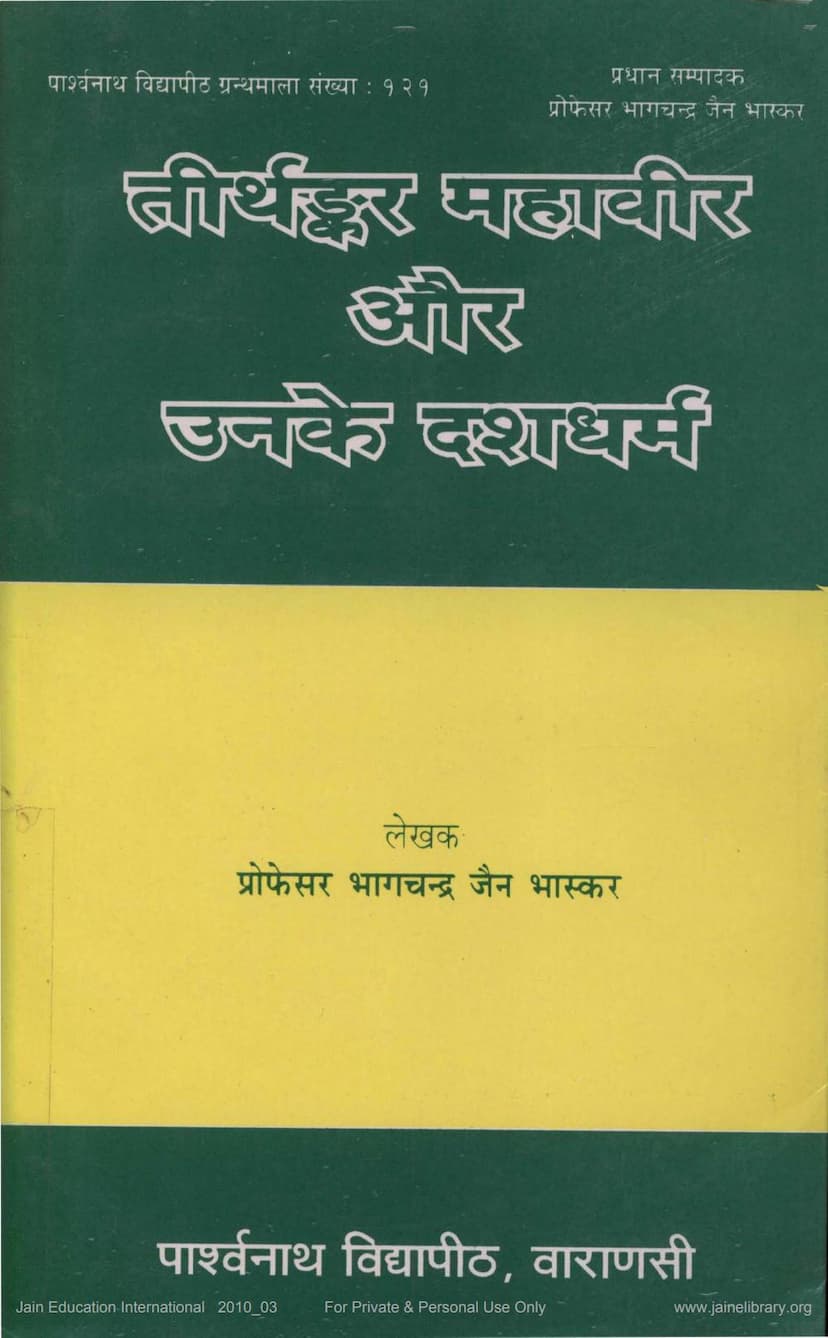Tirthankar Mahavira Aur Unke Das Dharma
Added to library: September 2, 2025

Summary
This document is the introduction and table of contents for the book "Tirthankar Mahavira Aur Unke Das Dharma" (Tirthankara Mahavira and His Ten Virtues) by Professor Bhagchandra Jain Bhaskar, published by Parshwanath Shodhpith Varanasi.
Here's a comprehensive summary based on the provided pages:
Core Theme:
The book focuses on Lord Mahavira, the 24th Tirthankara of Jainism, and his teachings, particularly the "Das Dharma" (Ten Virtues), which are considered the essence of Jain spiritual practice. It highlights the significance of the Paryushan festival as a period for spiritual introspection and adherence to these virtues.
Key Aspects Discussed:
-
Paryushan/Dashlakshan Parva:
- It's described as a crucial spiritual festival in Jain culture, observed annually, typically starting 50 days after the beginning of the Chaturmas (monsoon retreat).
- It aims to counteract the "refusal" of individuals to acknowledge the negative consequences of their sensory indulgences and attachments to worldly pleasures.
- The festival provides an opportunity for spiritual awakening, self-reflection, and the cultivation of virtues.
- The Digambara tradition calls it Dashlakshan Parva, emphasizing the ten virtues, while the Shvetambara tradition calls it Paryushan Parva. Both traditions celebrate a common day, often related to forgiveness (Khamat Khamna/Samyatsari).
-
Lord Mahavira and the Tirthankara Tradition:
- The book delves into the life and teachings of Lord Mahavira.
- It also traces the lineage of Tirthankaras, starting with the first Tirthankara, Rishabhadeva, and mentioning others like Arishtanemi and Parshvanatha.
- The historical significance of Parshvanatha and Mahavira is emphasized, with Mahavira being presented not as the founder but as a propagator of an ancient tradition.
- The pre-births (purva-bhav) of Mahavira are discussed, highlighting the concept of karma and spiritual evolution across lifetimes.
- Key events in Mahavira's life are narrated, including his birth, renunciation, ascetic practices, the hardships and challenges (upasargas) he faced, his attainment of Keval Gyan (omniscience), and his dissemination of teachings.
- The establishment of the Chaturvidha Sangha (four-fold community: monks, nuns, laymen, and laywomen) is detailed.
-
The Ten Virtues (Das Dharma):
- The book provides an in-depth explanation of each of the ten virtues that form the core of the Dashlakshan Parva:
- Uttam Kshama (Supreme Forgiveness): The absence of anger, understanding that anger arises from ignorance.
- Uttam Mardava (Supreme Humility/Gentleness): The absence of pride, characterized by softness and humility.
- Uttam Arjava (Supreme Straightforwardness): The absence of deceit and crookedness, promoting inner purity.
- Uttam Shaucha (Supreme Purity): Freedom from greed, leading to mental purity.
- Uttam Satya (Supreme Truthfulness): Speaking beneficial and truthful words, emphasizing the importance of right speech.
- Uttam Samyama (Supreme Self-Control): Restraining the senses and the mind, practicing discipline.
- Uttam Tapa (Supreme Austerity): Purifying the mind and shedding accumulated karma through penance.
- Uttam Tyaga (Supreme Renunciation): Letting go of attachment to worldly possessions and negative emotions, engaging in acts of charity.
- Uttam Akinchanya (Supreme Non-possession): Becoming free from all possessions, achieving detachment.
- Uttam Brahmacharya (Supreme Celibacy/Spiritual Discipline): Ultimate renunciation of sensual desires and absorption in the Self.
- The book provides an in-depth explanation of each of the ten virtues that form the core of the Dashlakshan Parva:
-
Jain Philosophy and Principles:
- The book touches upon core Jain principles such as Ahimsa (non-violence), Karma theory, the concept of the soul, liberation (moksha), and the importance of the Ratnatraya (Right Faith, Right Knowledge, Right Conduct).
- Anekantavada and Syadvada are mentioned as methods for understanding truth from multiple perspectives, fostering tolerance and reducing conflict.
- The philosophy emphasizes the importance of action (karma) over birth or dogma.
-
Cultural and Historical Context:
- The book connects Jainism with broader Indian culture, referencing Vedic literature and mentioning the historical figures of Rishabhadeva and his influence.
- The socio-economic contributions of Jainism and its historical spread across India and beyond are discussed.
Structure:
The table of contents reveals a structured approach, dedicating separate chapters to each of the ten virtues, preceded by foundational discussions on Paryushan, the Tirthankara tradition, and Mahavira's life.
Overall Purpose:
The book aims to provide a comprehensive understanding of Lord Mahavira's teachings, particularly the ten virtues, and their relevance in leading a spiritual and ethical life. It serves as a guide for spiritual seekers, especially during the auspicious Paryushan festival, promoting a deeper connection with Jain philosophy and practices.